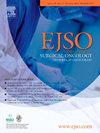Improved diagnostic decision making for microvascular invasion in HCC using a novel nomogram incorporating delta radiomics and body composition factors: A multicenter study
IF 2.9
2区 医学
Q2 ONCOLOGY
引用次数: 0
Abstract
Objective
To develop and validate machine learning(ML) models based on delta-radiomics features and body composition factors for early prediction of microvascular invasion(MVI) in patients with hepatocellular carcinoma(HCC) using a multicenter cohort,and to identify differentially expressed genes(DEGs).
Methods
This retrospective study included pathologically-confirmed HCC patients diagnosed at three centers.Radiomic features were extracted from MRI images,and delta-radiomics features were calculated.Clinical-radiological features, body composition factors and delta-radiomics score were selected through various feature selection methods and a nomogram was built based on the independent risk factors.The performance of the nomogram was assessed with the area under the receiver operating characteristic curve (AUC).Recurrence-free survival(RFS) analysis was assessed by the Kaplan-Meier analysis and compared using the log-rank test.Additionally, gene expression analysis was conducted to explore molecular mechanisms underlying MVI.
Results
The nomogram demonstrated numerically superior predictive performance in both external test sets, achieving AUCs of 0.853 (test set1) and 0.852 (test set2). The Delong test revealed the nomogram demonstrated robust predictive performance across both external test set, compared to the clinical model (test set1: 0.853 vs 0.790; test set2: 0.852 vs 0.774; both p < 0.05). No statistically significant difference was observed between the nomogram and delta-radiomics model(p > 0.05).The nomogram's implementation enhanced radiologists' diagnostic accuracy for MVI by up to 13.4 percentage points.The nomogram can categorize recurrence-free survival.DEGs associated with MVI are related to cell proliferation and glucose metabolism.
Conclusion
The ML models established via body composition factors and delta-radiomics scores had the best performance to predict MVI status,and help improve the diagnostic capability of radiologists.
一项多中心研究:采用结合放射组学和身体成分因素的新型nomogram方法改善HCC微血管侵犯的诊断决策
目的通过多中心队列研究,建立并验证基于delta放射组学特征和身体组成因素的机器学习(ML)模型,用于肝细胞癌(HCC)患者微血管侵袭(MVI)的早期预测,并鉴定差异表达基因(DEGs)。方法本回顾性研究纳入在三个中心诊断的病理证实的HCC患者。从MRI图像中提取放射组学特征,计算δ放射组学特征。通过各种特征选择方法选择临床放射学特征、体成分因素和放射组学评分,并根据独立危险因素构建nomogram。用受者工作特征曲线下面积(AUC)评价图的性能。采用Kaplan-Meier分析评估无复发生存期(RFS),并采用log-rank检验进行比较。此外,还进行了基因表达分析,以探索MVI的分子机制。结果nomogram在两个外部测试集中表现出了数值上优越的预测性能,auc分别为0.853 (test set1)和0.852 (test set2)。Delong检验显示,与临床模型相比,nomogram在两个外部测试集上都表现出稳健的预测性能(测试集1:0.853 vs 0.790;测试集2:0.852 vs 0.774;p <;0.05)。nomogram和delta-radiomics模型之间无统计学差异(p >;0.05)。nomographic的应用使放射科医生对MVI的诊断准确率提高了13.4个百分点。nomogram可以对无复发生存期进行分类。与MVI相关的deg与细胞增殖和葡萄糖代谢有关。结论通过体成分因子和放射组学评分建立的MVI模型预测MVI状态的效果最好,有助于提高放射科医生的诊断能力。
本文章由计算机程序翻译,如有差异,请以英文原文为准。
求助全文
约1分钟内获得全文
求助全文
来源期刊

Ejso
医学-外科
CiteScore
6.40
自引率
2.60%
发文量
1148
审稿时长
41 days
期刊介绍:
JSO - European Journal of Surgical Oncology ("the Journal of Cancer Surgery") is the Official Journal of the European Society of Surgical Oncology and BASO ~ the Association for Cancer Surgery.
The EJSO aims to advance surgical oncology research and practice through the publication of original research articles, review articles, editorials, debates and correspondence.
 求助内容:
求助内容: 应助结果提醒方式:
应助结果提醒方式:


